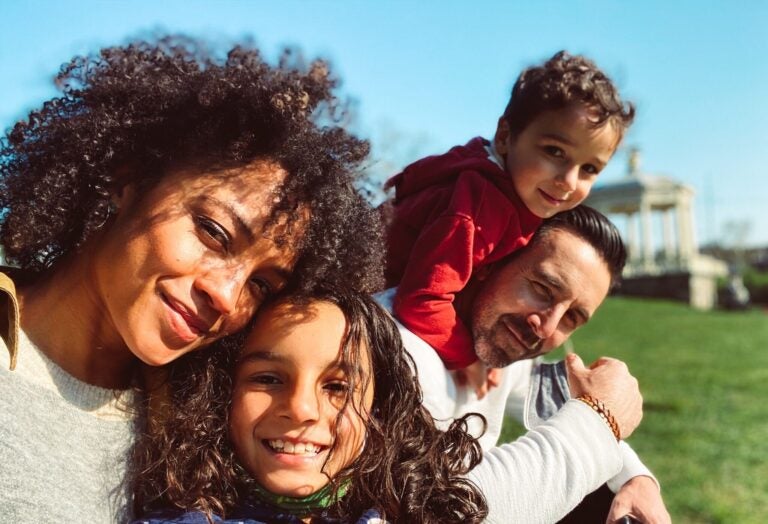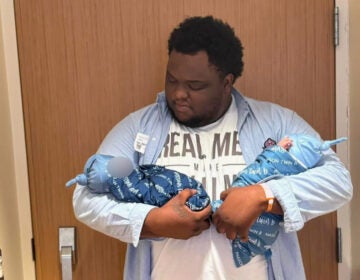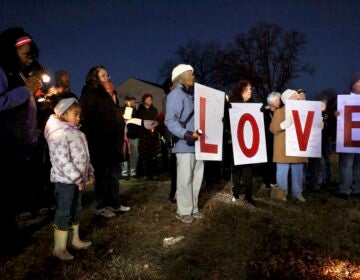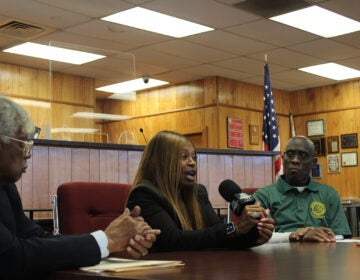How to start, or widen, the conversation about race with your kids
These talks are an everyday fact of life in some homes, but are new to others. Here is some advice on how to approach them, starting with young children.
Listen 2:53
Blair La May Masiello and her husband Michael Masiello with their kids. Courtesy of Blair La May Masiello)
Talking about race is part of growing up in many families, but to others it may be new as thousands of people take to the streets in and around Philadelphia daily, protesting George Floyd’s murder, police brutality, and deep-rooted systemic racism in America.
It’s not an easy conversation to have with your children, in any case. How do you explain to an 8-year-old why George Floyd died?
Blair La May Masiello and husband Michael Masiello have tried to be as honest as possible about what happened. They are an interracial couple, and their 8-year-old daughter has had lots of questions.
“She knows that there was a man who died who was Black, she’s going to know that an officer put his knee on his neck, and did it in large part because he was indifferent to that life underneath him,” said Masiello. They took their daughter to a protest organized by Fishtown Families Against Racism, a group La May Masiello worked to help start.
“She did have a lot of questions, you know, ‘Why are we kneeling?’ ‘What happened to George?’ And we took that moment to tell her what happened. But she wanted to see the video right away. And we said, ‘Absolutely not.’” said La May Masiello.
Her husband agreed: “She’s not going to watch the video because I think that’s where the education stops, and the horror begins, right? There’s no need for her to see him yell out for his mom, there’s no need for her to see him gasping for his last breath.”
Racism affects kids, whether their parents talk about it or not, said Wanjiku Njoroge, a psychiatrist and program director of the Department of Child and Adolescent Psychiatry and Behavioral Sciences at Children’s Hospital of Philadelphia.
“We’ve known for over 60 years the impact that racism has on Black children, Black and brown children, and I think now we’re beginning to see the impact it has on all children. So we need to talk about it,” Njoroge said.
When do you start? Earlier than you think
It isn’t going to be a single conversation for any family. And when possible, it’s good to start talking about it early.
“I don’t think there’s any time that’s too early to have conversations, both about race and racism,” said Barbara Thelamour, an assistant professor of psychology at Swarthmore College.
She drew a distinction between race and racism. “I think a lot of times we talk about race and it has to deal with all of the negative stuff that comes with race in this country. But people’s racial categories can also be a source of pride and strength for them.”
If you’re looking for a clear age to begin, Njoroge said conversations can start during the preschool years. According to the American Academy of Pediatrics, babies as young as 6 months old can notice racial differences, and children ages 2 to 4 start internalizing race-based biases.
There’s an added bonus to starting the conversation early. “You can build on those conversations, those experiences with your kids. But if you’ve never spoken about it, it’s like, ‘Wait a minute, where did this come from?’” Thelamore said.
Don’t feel comfortable talking to your kids? Well, chances are they’ll be talking to someone else about it.
“Children will make up their own ideas about how the world works. You’ll hear it with little preschoolers when they’re talking to one another about what they think is going on. And then they’ll tell it to one another, and depending on the certainty in one of their voices, the others might believe them,” Njoroge said.
Research shows teenagers of color have conversations about race early in life, often in response to their own experiences, Thelamour said, noting, “White teenagers tend not to get a lot of conversations about that, in part because of maybe parents’ own discomfort with the subject matter, in part because schools don’t do a very good job talking about these issues.”
Said Njoroge, “It’s not just about Mr. Floyd, or Arbery, or Breonna Taylor, or what happened with Christian Cooper. It is this continuing legacy, the story of year after year, after year, after year, and incident after incident, after incident, the small and the large. It’s the daily knowing that I need to get a receipt when I go to Target, because I can very well be stopped when I’m out leaving Target and asked about my purchases. Those kinds of things add up and they start in childhood, which is why Black families usually have many conversations with Black children about these kinds of issues.”
Small beginnings
The Masiellos also have a 3-year-old son, and even though he isn’t specifically asking about race yet, they’re trying to start the conversation in little ways.
“We have a book about Jackie Robinson, and he’ll say something like, ‘Well, why? Why are they piled on top of him? Why aren’t they letting him play?’ — just things that he’s visually seeing in the book,” La May Massiello said. “That gave us the opportunity to say, ‘Well, they didn’t want him to play because they didn’t want him to be better than them because his skin was Black. That’s, to me, right now with his age, the best way to really allow him to drive the ship as far as what questions he has and just understand that he kind of leads the way.”
For families of color who are already talking about this, Thelamour suggests that parents “not be too afraid to expose children to joyful narratives of race as well.” With younger kids, she said, that can be picture books, while for older kids it may be environments that show the beauty and strength people can find in race and “the fullness of Black life.”
“Not every conversation about race has to be [about] death and the police brutality, about the illness and the racism aspect,” said Thelamour.
If you haven’t talked to your kids broadly about race, here’s your chance, these experts said.
“So, when we’re seeing the protests, and calls for all sorts of reform, the words ‘systematic racism’ being used more frequently, it’s an opportunity to learn,” Thelamour said, “and, especially for white adolescents, an opportunity to really think: ‘Where do I fit in this larger narrative? I am white. I haven’t had to think about myself as white very often, more often than not. And so how does this work for me? What can I learn? Where can I learn about this?’”
Psychologist Jason Lewis, associate director of the outpatient program in the Department of Child and Adolescent Psychiatry and Behavioral Sciences at CHOP, said, “The last thing we want parents to be doing is judging themselves and beating themselves up at this point because they haven’t been having race conversations. But the good thing is that they’re recognizing that this is an important conversation that they want to have, and they want to start to have now.”

Show your support for local public media
Plan to plan ahead
“These are difficult conversations,” Lewis said, “so you really want to make sure you have the ideas set in your head as to what you want to talk about, what you want to communicate.”
If you don’t think you’ll feel comfortable answering your child’s questions, either do some research beforehand or be prepared to learn with them. You don’t need to have all the answers to start a conversation — but you do need to be prepared to become a student.
“If parents haven’t done some of this examination and thinking about these topics themselves, it’s really hard to turn around and have a conversation where certain questions can be asked … that they haven’t thought or read about — systematic racism, white racial identity, bias, prejudices, microaggressions,” said Thelamour. This is an opportunity to do some research alongside your kids.
She and Lewis suggested asking children what they’ve noticed from the news, social media, or even what they’ve overheard other adults say, and using that as a foundation for starting the discussion.
“I think we underestimate how much kids do pay attention to things, even when we’re not paying attention.” said Thelamour. “Talk about, maybe with younger kids, the feelings behind it, right? ‘So it’s a bad thing. Everybody’s really sad that this happened.’”
Going out to protest is a good idea, with some caveats.
“I encourage families to participate in protests, if that’s what’s important to a family,” Lewis said, advising that you look into events beforehand and pick family-friendly protests, planned during the day. “You know, one thing to think about with the younger children … the conversation that you might have with that 6- to 9-year-old might not address all of the very specific details, but it is important to keep in mind that those children are beginning to learn how to read and can read signs that they may see at the protest.”
He encouraged families who don’t necessarily agree with the protests to still discuss them and explain why they’re happening.
“Even if as an adult, you don’t agree with that, I think it’s still really important to have that conversation in a nonjudgmental way,” Lewis said. “To say that there are people who believe X, Y and Z, and that is why they are protesting. That is why they are making their voices heard. So that the next generation can make their decisions as to how they want to believe, how they want to act.”
Sarah Hyson, a white mother, likened it to exercise.
“Well, we need to be uncomfortable right now. If you think about it like physical exercise, it’s uncomfortable, and it hurts a little bit to get your body in shape, but it has to happen,” said Hyson, whose two sons, ages 9 and 12, are both white.
Continuing the exercise analogy, she said, “If kids start at a young age, before they are out of shape, then it’s never that uncomfortable, difficult situation for them because it was natural to begin with.”
The family lives in West Chester. Hyson said she tries to talk to her sons about race whenever it comes up, and keeps their house stocked with books that showcase narratives about all people, not just those who look or act like her boys.
For older children, Thelamour suggested social media. “Blogs and tweets from younger people who are really speaking out could be a great learning tool, outside of parents.”
Conversations with teenagers might be different — and if you find such discussions turning into debates, that’s OK, too.
“If you have a teenager who’s being a contrarian, they are clearly able to make the evidence for their argument. And I think that that’s helpful, right? Because, again, show me the data,” said Njoroge. Instead of shutting down discussions, encourage your teenager to show you compelling, well-sourced facts that support the argument.
Stressful times for all ages
Michael Masiello likened the current situation to building a rocket with one hand and keeping it from taking off with the other.
“We’re in uncharted waters,” he said. The coronavirus pandemic “put us squarely in that space, and then you add racial injustice, conflict, inter-community conflict, and you add the police element to that. And you add how close, localized, it really was for us in Fishtown. And what you get is a really, really interesting cocktail of things in the past week that have made the house stressful.”
“It’s been the hardest week, I think, ever for our family,” said Blair La May Masiello. “My body has been at a higher level of anxiety every single day, you know — go to bed that way, wake up that way.”
Even so, they’ve tried to provide positive distractions for their children.
“I know if I’m feeling it, that they must be doing something too. And we do see a little bit of change, you know, more tantrums and tired crying and things like that. And it’s so important, they’re not going to be just like, ‘Oh, I’m sad, because, you know, of Black Lives Matter.’ I mean, it’s going to come out in different ways,” La May Masiello said.
“You have an 8-year-old who’s incredibly inquisitive saying, ‘What’s going on? Why is daddy upset? Why is mommy rubbing [her] forehead?’ You know, ‘What did they just say in the news? Why are we making Black Lives Matter signs?’” Masiello said. “So, while you’re coping with your own anger, your own frustration, your own deep understanding of how screwed the system is if you look a certain way, and what to do with that energy. What to do with that anger. What to do with those emotions, then you have to transfer, you have to put on a hat, a teacher hat in the blink of an eye. It’s not only what we say, it’s how we say it, too.”
Njoroge, the psychiatrist from CHOP, encourages families to have these conversations, recognizing that they’re hard.
“The earlier they start, the easier it will be,” Njoroge said. “And … there will be tough days, there’ll be dark times when no matter if you started this conversation when your child was a preschooler and you were buying their toys and books and whatnot, that talking about Mr. Floyd is a hard conversation to have, but that needs to be had, and that there are a wealth of resources that are out there to help families think about having these conversations and help educators think about how can we do this work in the school.”
La May Masciello is glad she and her husband are talking about this with their daughter.
“It’s also a sad job to have as a parent, to know that you are introducing your child to something you’d rather not have to do, that you wish didn’t exist. But it is 100% necessary. And I am thankful that I’m the one, me and my husband are the ones that are doing it and that it’s not because she’s coming home crying about something that had happened to her.”
La May Masiello is biracial herself, and her husband is white. Their daughter’s skin is brown, she said, and their son is very light-skinned.
“Her features are … very much what she is, which is a mix of everything, and, you know, I said to her, people may not treat you and your brother the same.”
“That is a reality,” La May Masiello said, “and it is also something that for me mentally [has] been a weird thing to grapple with too, you know, having a son that he looks white, and but he’s Black, and he’s very Black to me. When stuff like this [is] going on, this being in everybody’s mind every second, it just makes you think, you know? It really puts things into an interesting perspective.”
WHYY is your source for fact-based, in-depth journalism and information. As a nonprofit organization, we rely on financial support from readers like you. Please give today.






